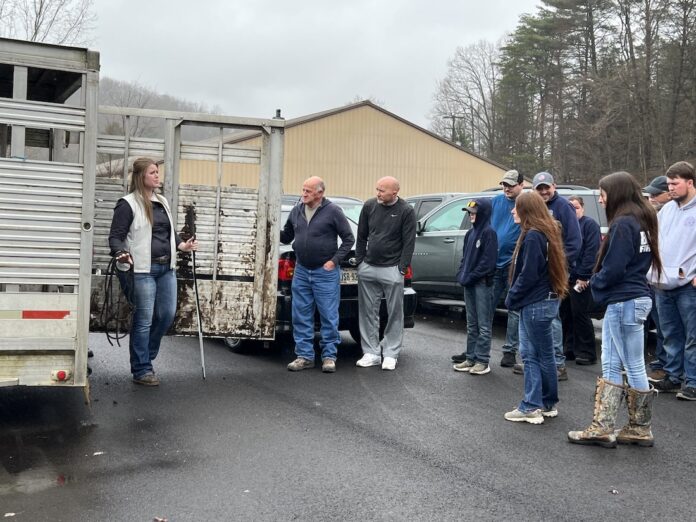
SCIO, Ohio — A few years ago, a livestock trailer hauling 200 pigs rolled over in Carroll County. After the accident, many of the pigs were loose. It was a first for many of the emergency responders on the scene.
“Nobody knew how to handle it. Nobody knew what to do with them,” said Peggy Horn, of the Carroll County Firefighters Association. After the incident, the firefighters who were on scene asked for training so they would be prepared if it ever happened again.
“They wanted everyone to know what they went through,” Horn said.
So March 9, at the Scio Fire Hall in Scio, Ohio, Haley Shoemaker and Erika Lyons, Ohio State University Extension educators for agriculture and natural resources in Columbiana, Harrison and Jefferson counties, led a livestock handling training for emergency responders. Nearly 40 first responders from Harrison, Carroll, Stark, Jefferson, Tuscarawas and Belmont counties attended.
“Today was perfect,” Horn said. “They covered everything.”
Safety
Preparing for trailer rollovers can be challenging partly because there are big differences between different types of livestock. For example, chickens and cows are handled very differently. And while it can be helpful to know what species and breed of animal you’re working with, animals in a high-stress situation can be unpredictable, Shoemaker said.
“There’s really no perfect way to predict how an animal is going to react when their trailer just flopped over and they have no idea where they’re at,” she said. “At the end of the day, we want folks to come home safe, and we want the livestock involved to be safe as well.”
There are some important things to know regardless of the type of animal emergency responders are dealing with, like making sure everyone remains calm, Lyons said.
“Animals don’t work on our time; we work on theirs,” Lyons said.
Incidents
Livestock hauling makes up about 7% of commercial trucking and accounts for less than 1% of accidents, Shoemaker and Lyons said, during the class. While these types of accidents are not common, they do create unique challenges.
“It’s not something we’re necessarily seeing as a rising issue. It’s always been there,” Shoemaker said. “But not everyone has the chance to be familiar with livestock.”
That makes it hard to respond to incidents like trailer rollovers when they do happen. Versions of the training Shoemaker and Lyons led are offered all over the state and country.
“The point of a livestock emergency response training is to better prepare our emergency response crews … to let them know what they need to be aware of in a situation that involves livestock,” Shoemaker said. “It kind of equips them with a knowledge base for handling triage and scene assessment.”
Demonstrations
During the training, Shoemaker demonstrated how to untie halters, open trailer gates and move livestock off of trailers.
She encouraged attendees to take their time unloading animals, to let them adjust.
“Going in and poking and prodding … is not going to help you at all. It’s going to get them excited. It’s going to get them scared,” she said.
In some cases, trailer rollovers involve dealing with injured or deceased animals, which may need to be moved to get other livestock out of a trailer or to clear a road. Veterinarian Matt Friend, of Friend Veterinary Services, in Hopedale, Ohio, covered how to move an animal that is unable to walk.
“The rule of thumb is to use the animal’s body,” Friend explained. He demonstrated how to use a fire hose or a tow strap to wrap around an animal’s body and move it without causing more injuries.
When animals are loose, it’s important to contain them safely. Shoemaker arranged a tabletop exercise with a miniature truck and trailer, along with miniature cows, to create an example of a trailer rollover with loose animals, and discussed how to assess the scene with the training attendees.
“Look and see what the surroundings provide you,” Shoemaker said. “Use what you have.”
For example, if there is a local farm with a fenced-in pasture nearby, responders can try to get in touch with the farmer to see if they’re able to use the pasture to contain animals temporarily.

Tools
Local farmers may also be able to lend corral panels or gates to help create temporary pens for loose livestock. But in many cases, emergency responders may already have some of the tools they need to handle livestock emergencies, Shoemaker said. For example, backboards or riot shields can be used as visual guides to move animals.
But one of the best things responders can do to be prepared for incidents is to have a plan and a list of contacts, including local farmers, who can help. Having a connection with a local veterinarian is important for fire departments, Friend said.
“The biggest thing would be having a plan in place … and a chain of command,” Friend said. “With livestock especially, a veterinarian is going to be an important block in that chain.”
(Sarah Donaldson is a freelance journalist who writes from Tuscarawas County, Ohio. She can be reached at sedonaldson13@gmail.com.)









